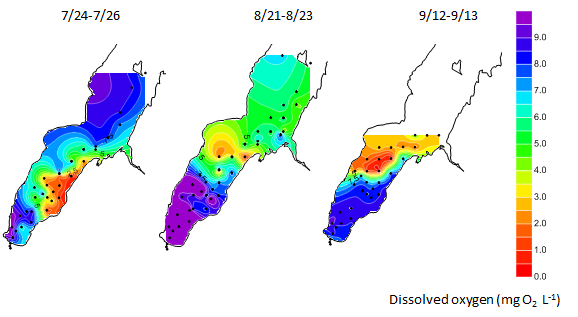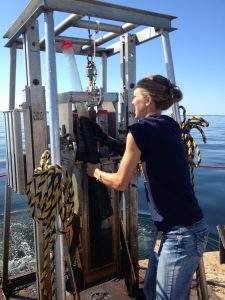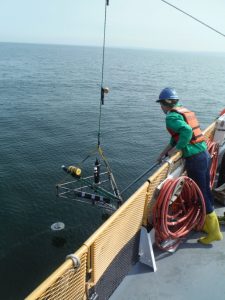Winter 2017 eNewsletter
Graduate Fellow Spotlight: Shelby LaBuhn
Understanding Green Bay Hypoxia Through Novel and Traditional Biogeochemical Techniques

Figure 1: Dissolved oxygen concentrations near the bottom of Green Bay during 2012. Low oxygen is shown in shades of orange and red.
In aquatic ecosystems, hypoxic areas or “dead zones” are regions that have low dissolved oxygen concentrations that negatively impact organisms and water quality. Lake Michigan’s Green Bay has been plagued by depleted oxygen levels for decades. The southern portion of Green Bay, where the Fox River empties, is particularly affected due to watershed hydrology and land use practices that lead to nutrient and sediment runoff (Figure 1). Recent studies have suggested that the hypoxia in this area may be worsening, raising concerns for the health of Green Bay and prompting increased monitoring and research to help inform resource management decisions. Reducing seasonal hypoxia has emerged as a primary management goal for improved ecosystem health in Green Bay.

Figure 2: Many sediment cores had to be collected with a box corer to measure sediment oxygen demand rates in Green Bay. Shelby LaBuhn, shown here, is collecting samples aboard the R/V Neeskay. Photo courtesy of Shelby LaBuhn.
Shelby LaBuhn, a 2015-16 CILER Great Lakes Graduate Research fellow at the University of Wisconsin-Milwaukee School of Freshwater Sciences (UWM-SFS), and her advisor, Dr. J. Val Klump, recently concluded a study that helped shed light on the growing problem of hypoxia in Green Bay. LaBuhn used a variety of traditional and novel techniques to characterize oxygen dynamics in Green bay and ultimately identify the key processes that consume oxygen and lead to hypoxia.
Oxygen production (via photosynthesis) and consumption (via respiration) in the surface waters of Green Bay was measured using both the traditional light-dark bottle technique, and using a novel diel oxygen cycle approach. The light-dark bottle technique uses clear and opaque bottles to simulate day (photosynthesis + respiration) and night (respiration) conditions. At the end of a light-dark bottle incubation, the change in dissolved oxygen over time in water-filled bottles is used to calculate the amount of oxygen produced by photosynthesis and consumed by respiration. In contrast, the diel oxygen cycle approach uses changes in free-water oxygen concentrations measured over a 24-hr period to perform similar calculations. LaBuhn used data from UWM-SFS’s Green Bay GLOS buoy to conduct her diel oxygen cycle analysis. The two techniques provided similar results for the production and respiration of oxygen in the surface waters, concluding that a slight net accumulation of oxygen and organic matter occur in the summer months.

Figure 3: Eddy covariance is a novel, non-invasive technique that was used in Green Bay during 2014 and 2015 to measure benthic respiration rates. The eddy covariance system is a tripod (being deployed) equipped with oxygen sensors that sits on the lake bed for 12 or more hours. Photo courtesy of Shelby LaBuhn.
Oxygen consumption in the bottom waters, where the hypoxic zone occurs, was measured using traditional sediment core incubations and a novel aquatic eddy covariance technique. Sediment core experiments have been a long-standing technique in limnology to improve understanding of sediment processes in aquatic ecosystems. LaBuhn collected sediment cores in acrylic tubes (Figure 2) and incubated them in the lab to measure the exchange of dissolved oxygen between the collected sediment and overlying water. In contrast, the eddy covariance technique (Figure 3) measures in situ oxygen exchange at the sediment-water interface using an instrument equipped with oxygen sensors and positioned on the lake floor. The respiration rates calculated from these techniques indicate that the sediments are the primary consumer of oxygen in Green Bay bottom waters.
The results from LaBuhn’s study, combined with data from other monitoring programs, were used to create a biogeochemical model (part of an integrated ecosystem model; see link below) for the Green Bay and Fox River watershed. The integrated model is being used by management agencies to evaluate treatment practices in the Fox River watershed and the potential effects these practices are having on Green Bay water quality, both now and under future climate conditions.
About the Author
Shelby LaBuhn was a CILER Graduate Research Fellowship recipient (2015-2016) prior to completing her Ph.D. at the University of Wisconsin-Milwaukee’s School of Freshwater Sciences (UWM-SFS). This fellowship provided several opportunities for Shelby to collaborate with her co-mentors Drs. Ashley Elgin (NOAA GLERL) and Tom Johengen (CILER) on hypoxia-focused projects. LaBuhn participated in a research cruise with Dr. Elgin aboard the R/V Laurentian in April 2016, as part of Dr. Elgin’s research to evaluate Dreissenid mussel effects on benthic respiration rates. In July 2016, Shelby spent two weeks with Dr. Johengen on western Lake Erie, collecting sediment cores and deploying the eddy covariance system to support Dr. Johengen’s hypoxia research.
Shelby was recently selected as a 2017 Sea Grant Knauss Fellow at NOAA’s Climate Program Office in Silver Spring, Maryland. Shelby will be working as an Ocean Observation Liaison in the Global Ocean Observing System Office.
Related Articles & Resources
- LaBuhn, Shelby and J. Val Klump. 2016. Estimating summertime epilimnetic primary production via in situ monitoring in an eutrophic freshwater embayment, Green Bay, Lake Michigan. Journal of Great Lakes Research. 42(5): 1026-1035. (Scientific Article)
- Green Bay Ecosystem Modeling (Model)
- Restoring the health of the Green Bay ecosystem under a changing climate: Modeling land use, management, and future outcomes (Presentation)
- In the News:
- Fellowships allow Freshwater students to wade into policy; UWM Report, 12/14/2016
- Shelby LaBuhn–Love of Math and Nature Leads Student to Lake Michigan Mud; University of Wisconsin Sea Grant Institute, 3/28/2016
- Green Bay dead zone shorter this year but still a threat; Milwaukee-Wisconsin Journal Sentinel, 11/5/2015
- Pollutants likely to create longest dead zone yet in Green Bay; Milwaukee-Wisconsin Journal Sentinel, 4/1/2015
- Dead zones haunt Green Bay as manure fuels algae blooms; Milwaukee-Wisconsin Journal Sentinel, 9/13/2014
